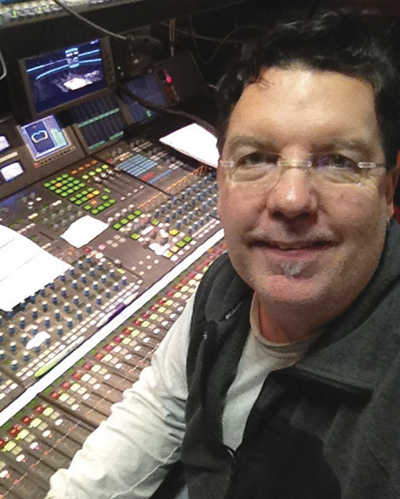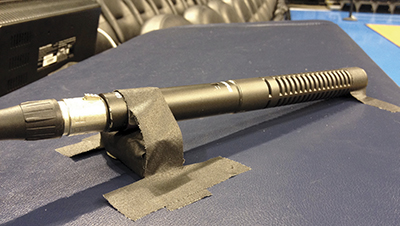Sports Producers Expand Audio Boundaries

Dave Grundtvig
LOS ANGELES—Shotgun microphones have long been indispensable in capturing the action at sports events. But with newer video technologies bringing audiences even closer to the action, audio mixers may employ additional solutions to more fully immerse fans in the onscreen competition.
“The picture is better, the lenses are longer, and you can get tighter and closer, so it just translates well to capture some of those sounds to go along with what you’re seeing,” said Dave Grundtvig, a veteran sports mixer currently covering NFL games for CBS who also has years of experience on NBA All-Star games and post season MLB games.
PICKUP PATTERN
To get in close, Grundtvig favors Shure’s SM89 shotgun, revamped a couple of years ago as the VP89 with a choice of short, medium, and long barrels. “Before, I would use a short condenser just because of my space limitations. Now, I’m able to use a short shotgun in its place to have a tighter pickup pattern—for example, on the basketball court.”
Placing long shotguns on the scores table is impossible, said Grundtvig. “But I’m now able to put shorter shotguns in the same place where I had condensers before. It helps immensely in rejecting a lot of the ambient noise and the PAs, which in all sports have gotten ridiculously loud over the last few years.”
Grundtvig positions five short shotguns on the table aimed at each basket and center court, and to either side of the center. “Then we’ll put 12 [Shure] Microflex MX391 boundary mics on the court. That does a fantastic job; it’s very low profile and captures the essence of the marching up and down the court.”
He also places boundary mics below the baskets “to capture the trash talking and the ball bounce. It uses the floor to help reinforce as the boundary, and has great rejection.” The court effects mics are submixed and the feed sent to Grundtvig.
Get the TV Tech Newsletter
The professional video industry's #1 source for news, trends and product and tech information. Sign up below.
“I use shotguns for overheads; Sennheiser is my favorite,” said Lance Gordon, who mixes the two 13-week seasons of Spike TV’s “Belator MMA” and many of ESPN’s 40-week season of “Friday Night Fights.” “And Sennheisers on the boom poles; you can’t beat them.”
Some mixers use two shotguns on a boom, he said: “One long, for when the fighters are far from the action, and a shorter shotgun for when they’re right up against the ropes.”
But typically Gordon gets by with long shotguns: “I get plenty, even when the fighters are up close, because the camera guys in that case will back out so that they’re not in the wide shots.”

A Shure VP89 shotgun mic is placed on the boundary of a basketball court to capture audio. Gordon has designed an array of shotguns to cover his mixed martial arts bouts. “It’s a cluster of five Sennheiser MKH 8060 microphones,” he explained: one in the center, picking up the center of the ring, with the other four splayed to capture the rest of the circular cage. Those are supplemented by lavs placed under the pad around the ring, “for when they’re grappling on the ground,” in addition to the mics on the handheld cameras.
NFL SOUNDSCAPE
One big change in NFL coverage that brings the audience closer to the action is relatively recent, according to Phil Adler, who also mixes NFL games for CBS, and handles college basketball for CBS and CBS Sports Network. The umpire’s mic used to pick up the quarterback’s calls, but after the NFL moved the official to the offensive backfield, to avoid being run over by the offensive team, there was a year without any on-field audio, he said.
“The NFL said, ‘We’re missing an awful lot of our soundscape here.’ They came up with the idea of miking players.”
Either a center and back-up center or two guards wear the mics, a decision made by the respective teams. “If we’re lucky enough to get centers on both teams and they’re working, it’s incredible, unbelievably good,” said Adler.
Wireless Mics: When Bandwidth Is an Issue
Delivering mic signals to the sports audio mixer from the field of play, sideline, or studio typically involves both wired and wireless transmission. With the FCC and telcos putting the squeeze on the UHF bandwidth, Sony is offering two digital wireless mic systems—the DWX and DWZ Series—that enable sports broadcasters to cope with a constrained RF spectrum.
Where six simultaneous channels are enough, Sony’s DWZ Series system, operating at 2.4 GHz, provides an alternative to UHF transmission, plus improved audio quality over analog equivalents. Equipment in the ISM radio bands typically requires unobstructed line-of-sight and a limited (100 feet) working distance.
Supporting up to 12 channels, Sony’s DWX Series, offering dual-channel UHF operation, makes use of a separate 2.4 GHz RF carrier to remotely control transmitter settings such as TX frequency, mic pre gain, and DSP low cut filter.
Both offer a flexible choice of handheld microphone sound characteristics.
The player feeds are completely under the auspices of the NFL, which keeps the signal chain under wraps, he said. “I believe it’s being sourced from Zaxcom,” Adler said. “It’s encrypted wireless transmissions from the players to a mixing position manned by NFL Films freelancers.”
Unfortunately, for unknown reasons, the gear has not been trouble-free. On a recent game, he said, “After about four plays in the first quarter we lost the mics on the Vikings and they never came back.”
On its golf coverage, to immerse audiences into the action during the Masters and other tournaments, CBS uses a variety of shotguns, reported Adler, who is not working the tours but has visited several of the games. CBS, which broadcasts in 5.1, captures as much as possible in stereo, he noted.
“They have a stereo mic that they put on a stake at the tee shot. On the greens you’ve got two stereo shotguns. In the gallery, especially on the 18th hole, CBS is using [Audio-Technica] 4050ST stereo mics for the crowd, which sound fantastic.”
There are also long shotgun operators on the fairway, and what are referred to as “bird mics” in the trees, said Adler. “They capture the sounds of the birds. That helps to make the transitions from one hole to the next, and going in and out of tape, as seamless as possible.”
Across the industry, mono shotguns are often run through a mono-to-stereo converter, he reported. “These days we’re all making the transition to the DTS DaySequerra gear.” For NFL games, he said, “I run my parab submix through it.”
“You don’t generally have enough channels to put stereo mics on everything,” observed Gordon, who also noted that the available stereo mics are not necessarily suited to his applications. But on Belator he has nine camera mics—too many for the available stereo synthesizer channels.
“What I’ll do is take a mic, send it out to the synthesizer, then return that into a stereo fader. When a tape operator takes that camera and iso’s it, and I play it back, it’s a stereo camera. That’s a cool little trick that we do, and a very common process with most shows.”
Steve Harvey began writing for Pro Sound News and Surround Professional in 2000 and is currently senior content producer for Mix and a contributor to TV Tech. He has worked in the pro audio industry—as a touring musician, in live production, installed sound, and equipment sales and marketing—since November 1980.
